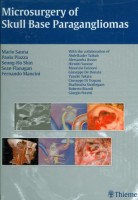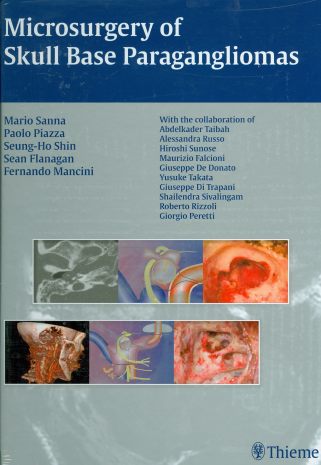 Authors: Mario Sanna, MD, Seung-Ho Shin, MD, Paolo Piazza, MD, Sean Flanagan, MD, and Fernando Mancini, MD
Authors: Mario Sanna, MD, Seung-Ho Shin, MD, Paolo Piazza, MD, Sean Flanagan, MD, and Fernando Mancini, MD
Publisher: Thieme – 702 pages
Book Review by: Nano Khilnani
It is unusual that multiple editors or authors of a book are located in different countries, but that is the case here. It must take a lot of effort to coordinate the work of planning the contents, writing and compiling articles, editing them, providing appropriate graphics, and the other tasks of putting all of this together to come up with an excellent, authoritative book as is this one.
Drs. Sanna, Piazza, and Mancini are from three different cities in Italy: Chieti, Parma, and Turin, respectively; Dr. Shin is from Seongnam in the Republic of Korea, and Dr. Flanagan is from Sydney, Australia.
A paraganglioma is a kind of neoplasm or abnormal mass of growth of tissue that can develop at various sites of the human body such as the abdomen, chest, head, neck or other places. About 97 percent of paragangliomas are benign (not deadly), but the other 3 percent are malignant and can lead t death.
In 85 percent of cases, paragangliomas develop in the abdominal area; about 12 percent emerge in and around the chest, and only 3 percent occur in the head and neck region, according to a Wikipedia article. But the head and neck are places that contain important nerves and vessels critical to thinking and breathing functions, and essential to human survival. There are vital structures in the head and neck region, such as the lower cranial nerves and vertebral arteries.
In this book, Dr. Sanna states categorically that a detailed neuroradiological examination is mandatory in order to develop a treatment program including surgery.
He writes that this book importantly provides:” a surgical framework for the management of these tumors (paragangliomas) followed by an extensive section providing detailed work-through of specific cases at each stage of disease, highlighting the specific techniques to be used and difficulties expected to be encountered.”
Each section is illustrated with multiple high-quality surgical and radiological images. He goes on to inform us that the content of this book is essentially based on 30 years of experience and more than 350 operated cases.
So what does this book cover on the subject of paragangliomas? The range of topics and types of tissues covered is of a large range, to say so briefly. And the volume of information presented in this large-size book (12.5” long by 9.4” wide) of more than 700 pages is almost encyclopedic.
This textbook of 20 chapters begins with an Introduction to definitions, and the epidemiology, pathology, pathophysiology, and genetics of paragangliomas: it also provides you a historical overview of these types of abnormal tissue types.
Then its four subsequent chapters (second to fifth) provide you some anatomical bases from a surgical and a radiological perspective; followed by clinical presentations, diagnostic work-ups, and treatment options and the important final step of decision making.
The sixth chapter discusses interventional neuroradiology, including general principles of embolization of different types of paragangliomas. The seventh chapter has discussions on preoperative preparation, patient care, and nerve monitoring. Then three chapters (eighth, ninth and tenth) are presented: on surgical management of two different classes of tumors; and of vagal paragangliomas.
Eight other chapters (eleventh to eighteenth) continue, with their focus on management of: different types of paragangliomas, other tumors, and areas that are susceptible to develop such abnormal masses, namely: complex tympanojugular paragangliomas, carotid body tumors, facial nerves, the internal carotid artery, large intracranial and extracranial veins, lower cranial nerves, intradural tumor extension, and tumors involving the vertebral artery
Finally, the last two chapters deal with how to deal with complications that may arise after surgery.
This is an excellent and outstanding book on paragangliomas. It is not only broad in scope but also deep in details. The following authors have done amazing work that is very useful and valuable to those who work in all related medical and surgical specialties:
Mario Sanna, MD is Professor of Otolaryngology in the Department of Head and Neck Surgery at the University of Chieti in Chieti, Italy.
Seung-Ho Shin, MD is an Assistant Professor of Otology and Neurotology in the Department of Otolaryngology-Head and Neck Surgery at Cha University in Seongnam in the Republic of Korea.
Paolo Piazza, MD is an Interventional Neurologist in the Department of Radiology at the University of Parma in Parma, Italy.
Sean Flanagan, MD is Conjoint Lecturer in the Department of Otolaryngology-Head and Neck and Skull Base Surgery at St. Vincent’s Hospital in Sydney, Australia
Fernando Mancini, MD is (in Italian) Gruppo Otologico, Casa di Cura “Placenza” in Placenza and Rome, Italy. He is also an Associate Otolaryngolist in Turin, Italy.







